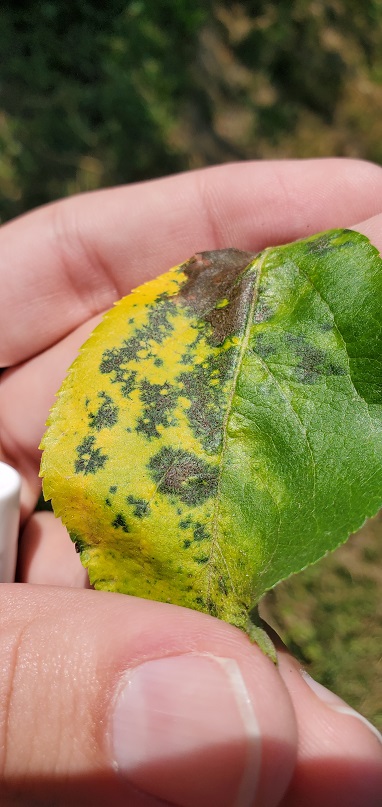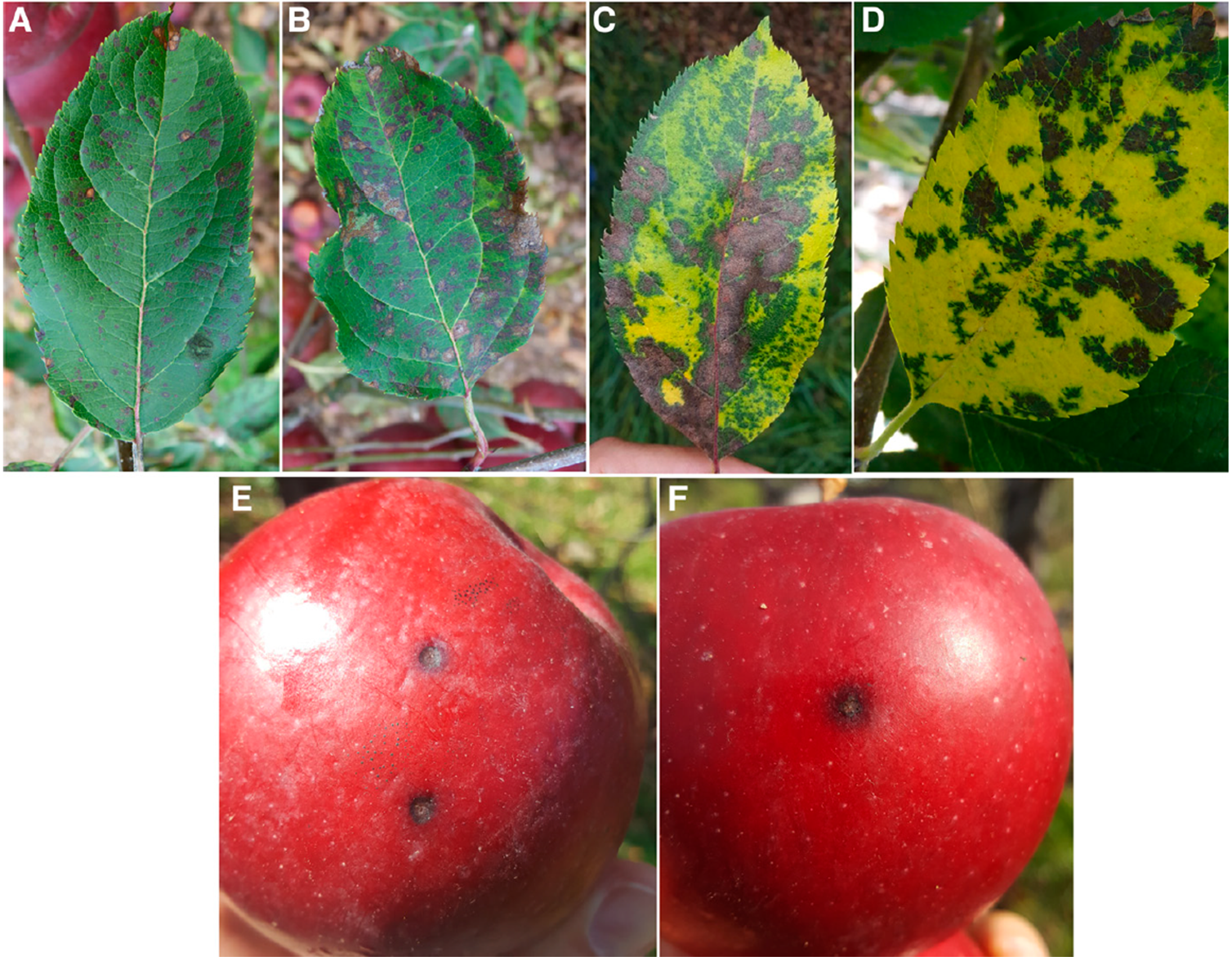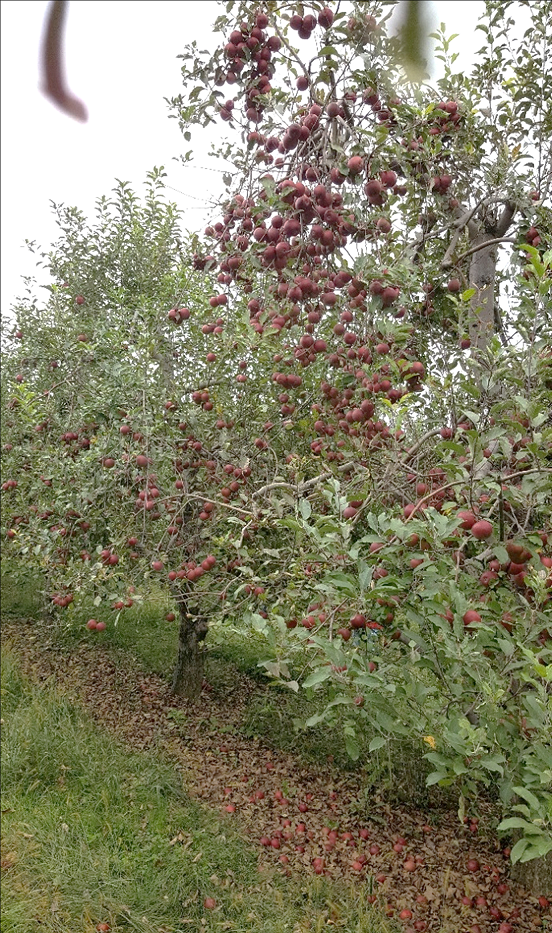Marssonina Leaf Blotch Caused by Fungus Diplocarpon coronariae Visible in Shenandoah Valley

On 29 August 2022 we detected Marssonina Leaf and Fruit Blotch in a classic training system orchard of ‘Ginger Gold’ in Winchester, VA. The orchard was well protected until harvest, but after fruit were picked, disease moved in, and infect and yellowed some leaves. This disease is also known as Apple Blotch Disease (ABD). The symptoms were found on the lower scaffolds in the canopy and are visible in Figure 1. This disease primarily expresses on apple leaves and is caused by a pathogenic fungus Diplocarpon coronariae. Since we experienced very wet weather in whole Virginia, which favored the development of ABD, any poorly protected orchards that had long gaps in fungicide coverage will be expressing this disease. Leaf symptoms express as grey to dark brown large round spots (blotches) that can merge, thus leading to leaf yellowing. It is important to note that after harvest of fruit, disease pressure can build up since fungicide coverage has ceased. This can be a problem for next year due to higher inoculum carryover.



This disease was first visually diagnosed in September 2017 and widely present in orchards in Pennsylvanya, New York, North Carolina, Virginia. The cultivars we found can be infected are Mutsu, Honeycrisp, Gala, Red Delicious, Golden Delicious, Goldrush, Ginger Gold, Williams’ Pride, Pristine, Grimes Golden, Northern Spy, Stayman Winesap and Tompkins King. Disease is also reported as a problem in Canada, Brazil, Panama, India, China, Taiwan, Korea, Japan, Romania, Italy, Germany, Austria, Switzerland and others. In Europe the most affected cultivars are Topaz, Jonagold, Gala, Golden Delicious and Luna, while in Asia it is Fuji. Cultivars that are resistant to apple scab fugus are notoriously susceptible to ABD. ABD symptoms on fruit are rare but can occur on defoliated trees (from high infection pressure) and we were able to find them in the orchard and in the storage (infections can establish on fruit just before harvest and express much later in storage) (Fig. 2 E, F)
If fungicides are not applied, ABD can be a persistent a problem in conventional and organic apple orchards, but is especially a problem in orchards where reduced spray programs are applied in a year very frequent rains during late spring and early summer. The primary plant host for D. coronariae is apple (Malus x domestica), other shrub species can be infected by this fungus and serve as inoculum sources: Siberian crabapple (Malus baccata) and deciduous spiny shrubs called Chaenomeles species (Maule’s quince aka Japanese quince, Chinese flowering quince, Tibetan quince and Chaenomeles cathayensis). Trade with nursery material that can carry the infected leaves allows introduction of ABD in new distant regions.
The fungus overwinters in fallen leaves on the orchard floor. Ascospores as a product of sexual reproduction of the fungus cause first infections in spring. They form in the overwintered cup-like fungal structures called apothecia that develop on the leaf litter from last year. It is not known whether these reproductive bodies can form in the conditions of Virginia. In many parts of the world, the fungus overwinters in the form of the asexual spores (conidia) on fallen leaves. Conidia release starts sometime in June and continue to infect current year leaves until the early November, if conditions are favorable. After spores facilitate infection the incubation is very long. To express as blotch, leaf infections need extended period of moisture i.e. leaf wetness of 40 – 45 days (high relative air humidity), and temperatures between 20 to 25°C. It is possible that infections can initiate sometime in April May or around first or second week of June. In the orchard, fungal spores disseminate by rain and wind.
Currently we have only one fungicide labelled for control of ABD, which is Cevya. However, various researchers point that that thiophanate-methyl (Topsin-M), SI fungicides such as Inspire Super (contains difenoconazole from FRAC group 3), QoI trifloxystrobin (Flint), and Merivon which combines an SDHI fungicide fluxapyroxad (FRAC group 7) and QoI pyraclostrobin (FRAC Group 11), are effective in controlling Marssonina fungal species that infect apple and/or poplar. However, none of these fungicides carry a labelled use for ABD on apples in the U.S. EBDC fungicides such as mancozeb or metiram are known to be effective but have no labelled use for ABD in the USA and have limited utility during summer because of 77 days pre-harvest interval. Copper fungicides are not very effective while research outside U.S. points that effective fungicides in ABD control are FRAC 11 kresoxim-methyl (Sovran), and DMI-s flusilazol and prochloraz (none have current label for ABD). Overuse of these single-site fungicides can lead to development of resistance in D. coronariae populations and unacceptable accumulation of residues in fruit. Dr. Kari Peter at Penn State ranked fungicides into a few efficacy categories in Figure 4 based on preliminary observations made in Pennsyvania, however, more efficacy trials are needed to confirm these results.

In organic apple production ABD can have a devastating impact. Trees must be planted on a well raised and windy spot. It is imperative to prune the tree crown to facilitate good air circulation and to eliminate leaf litter as the major infection source on the orchard floor. The same recommendations to reduce overwintering apple scab inoculum by shredding and degrading leaf litter are useful here. If you had ABD in your orchard, you should reduce inoculum abundance by promoting biological processes of degradation of leaf litter in fall, spring, or both in fall and spring. To quicken the degradation of leaf litter you should increase the activity of microorganisms and worms on and in the soil. In conventional orchards, you can spray apple leaves on the tree with urea just 1-2 days before the major leaf drop in fall (first severe frost) or as leaf litter on the orchard floor. When leaves are on the branches you will have better coverage with urea. Make sure this practice is done late enough in fall and start of winter to avoid promoting any late growth with sprayed nitrogen. If you were late to the game and will be spraying leaves on the orchard floor, the best time is to apply urea in late winter but before bud break. Turn air deflectors of your air-blast sprayer downward and/or turn off top nozzles to allow spray mist to lift loose leaves and coat them with urea. Use the rate of 40 lbs of urea / A in 100 gals of water (wash and rinse well your spray equipment since urea can wear up any rubber parts, washers, and gaskets in the sprayer).
In organic apple orchards urea is not allowed. When ground is without snow cover and it is not muddy, use flail mower using a scalp mode to shred leaves to smaller pieces instead (this method can also be combined with urea in conventional apple orchards). If practical, rake leaves into row middles from under the trees and remove leaf piles with flail mower mode for scalping the sod. Instead of urea, lime can be applied in both organic and conventional orchards at a rate of 2.5 tons / A. If lime is used, it is better to apply it after the leaf drop in fall or early in the winter. Lime increases pH or basicity of soil, thus promoting microbial activity and litter breakdown. Both practices can reduce apple scab inoculum for around 50% and we are not sure has the reduction effect ever been quantified on overwintering spores of D. coronariae.
Reduction of ABD inoculum with above specified practices does not mean you do not need to spray fungicides against this disease next spring and summer. Enough inoculum can always survive in your or neighboring orchard to cause infection. However, inoculum reduction secures better efficacy of your fungicide sprays and reduces the overall chance for severe ABD infections. Recent work in Germany showed that in organic orchards 10-12 sprays per year of each of the following products: copper hydroxide, lime sulfur, or sulfur provide relatively good control if the first spray application is started around 10-12 June (Bohr et al. 2018). These treatments allowed only 4-15% of ABD incidence in one and 5-25% in second test year. To properly time fungicide sprays for maximum efficacy in ABD control in both conventional and organic orchards, use of RIMpro’s Marssonina prediction model that is based on 10-day weather forecast is highly recommended and especially helpful in orchards that had severe ABD outbreaks in the past (RIMpro B.V., Zoelmond, Netherlands). More information about this model can be found by here: https://www.rimpro.eu and by clicking on the button “Pricing & Create Account”.
